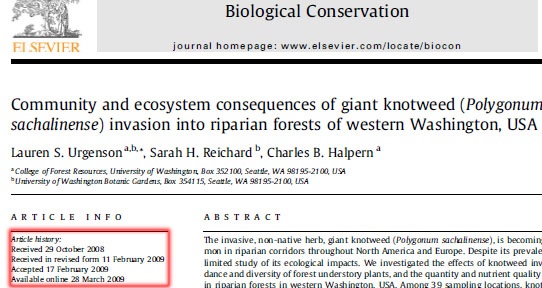This handout specifically addresses Primary Sources in Science. For information about locating Scholarly and Peer-Reviewed journals in general, see Identifying Scholarly Journals.
Primary Research Literature
In the sciences, primary literature reports on research conducted by the authors.
When you see an article in a scientific journal, there are several clues that it is primary literature. The most important clues are 1, 2, 4, and 5 below.
1. The authors are identified.
2. The authors' affiliations are identified. These are usually universities or scientific institutions.
3. Sometimes the abstract shows evidence that the article is about the author's own research:
4. The authors explain how they did their research. Look for a "Methods," "Materials and Methods," or "Experimental" heading within the article. In shorter articles, often called brief reports, short communications, or letters, there won't be any internal headings but if you read carefully, you will find a brief explanation of how the authors did their research.
5. The authors report their findings. Look for a "Results" heading within the article." In shorter articles, often identified as brief reports, short communications, or letters, there won't be any internal headings, but if you read the article you will find that the authors report their findings.
6. The authors identify the references they used as background for their research. Science advances by building on previous research, and it's important to acknowledge the work that has gone on before. Note that secondary literature, such as review articles also have references. (For more on review articles, see What's Not a Primary Research Article below.) However, the absence of any references is a strong clue that you are not looking at a primary article.
7. Primary articles often contain graphs and tables. However, secondary literature, such as review articles may also have graphs and tables.
Peer Review
Primary articles are often peer reviewed (sometimes called "refereed"). However, secondary literature, such as review articles may also be peer reviewed.
Peer review means that the article was read and critiqued by other experts on the topic at the request of the editor of the journal. Often the peer reviewers will ask for clarifications or changes to the article. Once the authors have completed their revisions, the article is accepted.You can often determine that an article is peer reviewed by looking at the article for the date received and the date accepted or date published. The article was peer reviewed in the interval between those dates.
- Sometimes the indication appears just below the authors and affiliations.
- Here's another possibility for indication of peer review near the start of an article:
- Sometimes the peer review information is at the bottom of the first page of the article:
- Sometimes it is at the end of the article after the references:
- Even if you cannot find any dates, the journal could be a peer reviewed journal. Try entering the journal title into Google. The publisher's website for the journal is usually among the first several results. Publishers are proud to publish peer reviewed journals and will usually indicate peer review in their websites. Look for links like "About this Journal," or "Librarian information." Here's an example:
What's Not a Primary Research Article?
- News reports about research--though the report may have information you can use to find the primary research article.
- Encyclopedia articles --never report original research.
- Review articles. These are surveys of the literature on specific topics that summarize and explain the research of others and/or the previously published work of the authors, and are considered secondary sources. They often look very similar to primary research articles, but they are not. Here's how to tell:
- No "Methods," "Materials and Methods," or "Experimental" section or details. (Compare to #4 in the section on primary research articles above.)
- No "Results" section or details. (Compare to #5 in the section on primary research articles above.)
- The authors reference other sources throughout the paper. (In primary research articles, most references to others' work are generally confined to the introduction and discussion sections.)
- Databases like Science Direct may indicate review articles.
- Journals may highlight review articles. Look for a header on the first page of the article.
- Sometimes the article title contains the word review:
- Sometimes the abstract or summary mentions that the article is a review:
- Sometimes the information is found in the introductory section
Identifying primary research and peer review articles gets easier with practice. If you have questions about an article, just ask.















